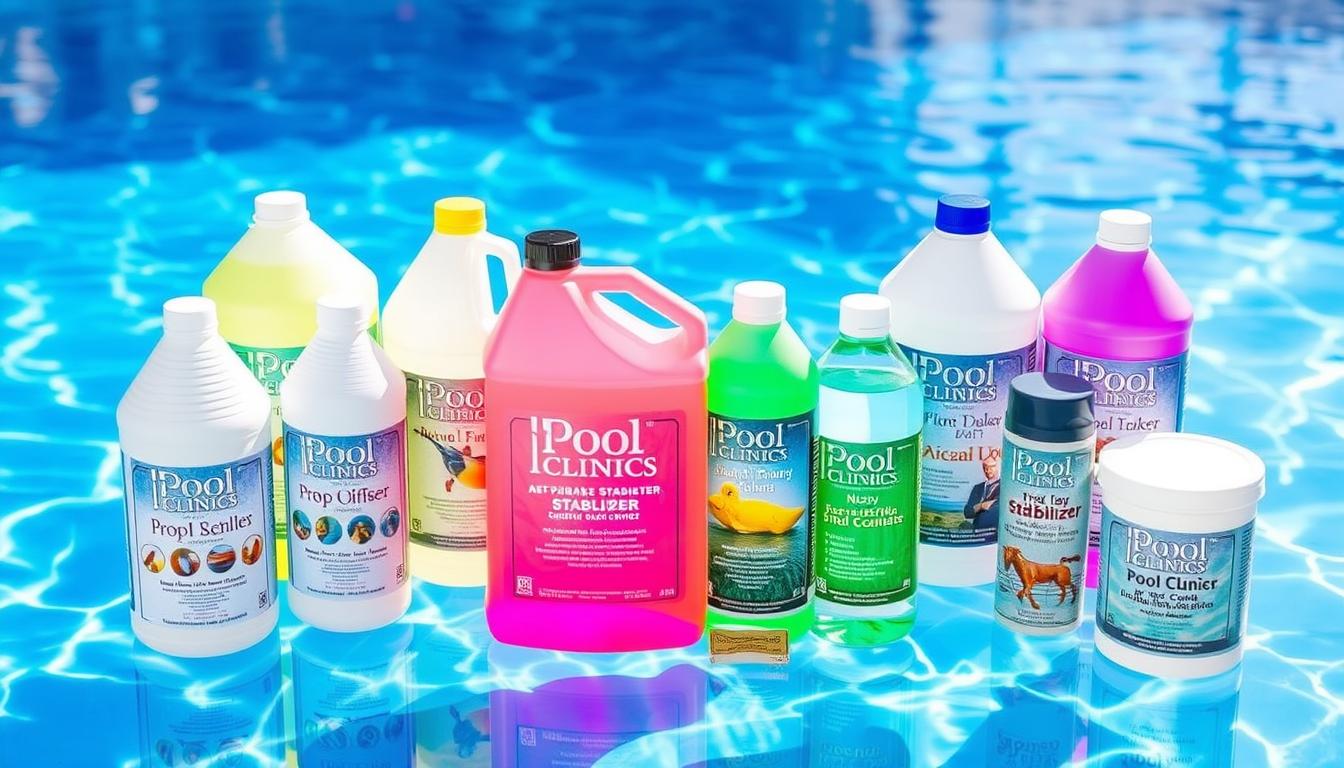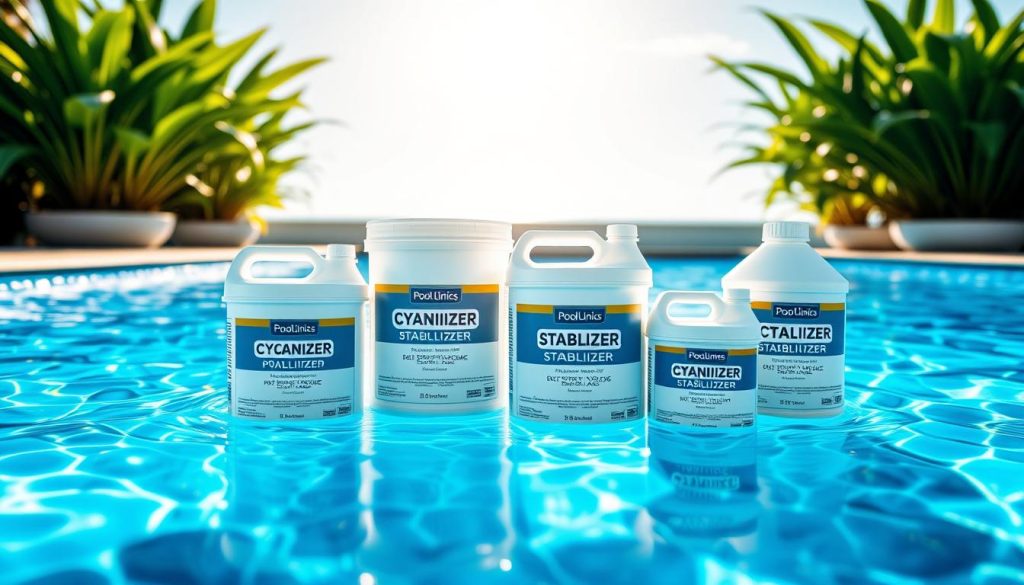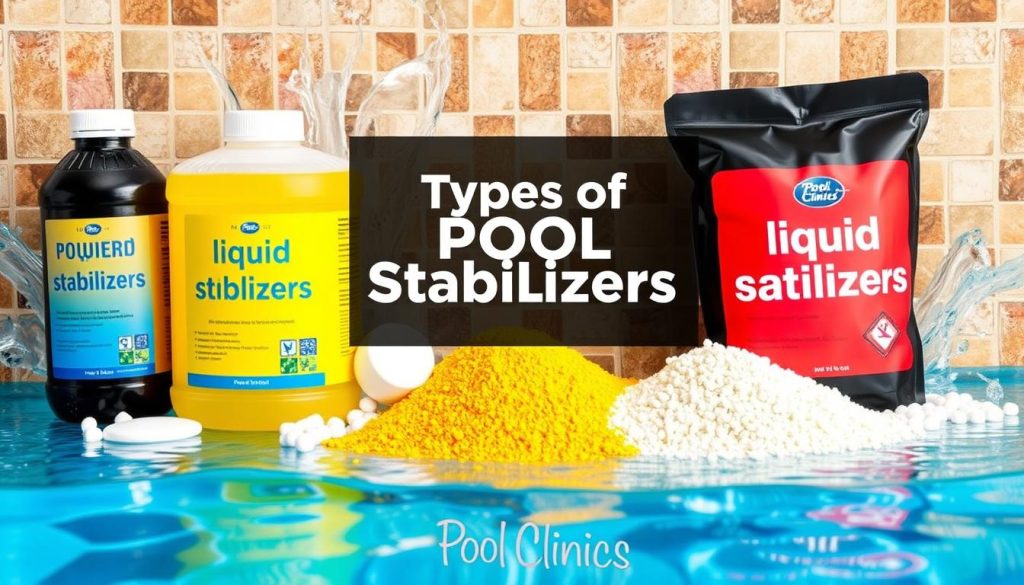
Is your pool water staying clean despite regular chlorine treatments? The issue might be low stabilizer levels. Cyanuric acid, or pool stabilizer, is vital for a healthy swimming environment.
It keeps chlorine effective in sanitizing the water. Without enough cyanuric acid, UV rays can quickly deplete chlorine. This leaves your pool open to algae growth and other contaminants.
Proper stabilizer levels are crucial for effective chlorine use. They protect chlorine from breaking down due to sunlight. Let’s explore how to increase stabilizer in your pool.
Key Takeaways:
- Pool stabilizer, or cyanuric acid, protects chlorine from being depleted by the sun’s UV rays.
- Ideal pool stabilizer levels range from 30 to 70 ppm, depending on the type of pool.
- Regular testing and adjusting of stabilizer levels are crucial for maintaining a clean and safe pool.
- There are various pool stabilizer products available, including stabilized chlorine, liquid stabilizer, and powder stabilizer.
- Proper pool stabilizer maintenance can help prevent algae growth and ensure optimal chlorine efficiency.
What is Pool Stabilizer and Why Do You Need It?

Pool stabilizer, or cyanuric acid (CYA), is vital for a healthy, clear swimming pool. It shields chlorine from the sun’s UV rays. This chemical extends chlorine’s lifespan, keeping it effective for pool sanitation.
Understanding Cyanuric Acid in a Pool
Cyanuric acid is a white, granular substance that easily dissolves in water. It binds with free chlorine molecules, creating stable chlorinated isocyanurates. This bond protects chlorine from UV rays, which can quickly break it down.
Why Stabilizer is Important for Chlorine Levels
Without stabilizer, chlorine levels in your pool can deplete rapidly, especially on sunny days. This means more frequent chlorine additions, which is time-consuming and costly. Cyanuric acid helps maintain consistent chlorine levels, ensuring a safer swimming environment.
| Cyanuric Acid Level (ppm) | Effect on Chlorine |
|---|---|
| 0-30 | Insufficient protection, rapid chlorine depletion |
| 30-50 | Ideal range for chlorine stabilization |
| 50-100 | Reduced chlorine effectiveness, longer bacteria killing times |
| 100+ | Chlorine becomes significantly less effective, potential health risks |
Effects of Low CYA Levels on Pool Water
Low CYA levels in your pool can lead to a host of issues, including:
- Rapid chlorine depletion, requiring more frequent chlorine additions
- Inadequate sanitization, allowing bacteria and algae to thrive
- Inconsistent chlorine levels, making it difficult to maintain a safe and healthy pool
- Increased risk of chlorine-related irritations, such as red eyes and skin irritation
Maintain proper CYA levels in your pool, typically between 30-50 ppm. Regular water testing helps keep stabilizer levels optimal. This ensures UV protection for chlorine, keeping your pool clean and inviting.
How to Add Stabilizer to Your Pool?

Adding stabilizer to your pool keeps chlorine levels optimal. It ensures clear and healthy pool water. Let’s explore the key factors for adding stabilizer effectively.
Different Types of Pool Stabilizers: Granular vs. Liquid
Pool stabilizers come in granular and liquid forms. Granular stabilizers, like cyanuric acid, are common and widely available. They need pre-dissolving in water before adding to the pool.
Liquid stabilizers can be poured directly into the pool water. This makes them a more convenient option for some pool owners.
| Type of Stabilizer | Pros | Cons |
|---|---|---|
| Granular | – Widely available – Cost-effective |
– Requires pre-dissolving – Can take longer to distribute evenly |
| Liquid | – Easy to add directly to pool – Distributes quickly |
– May be more expensive – Can be harder to find |
Step-by-Step Guide to Adding Stabilizer
- Test your pool water to determine the current CYA levels and the amount of stabilizer needed.
- If using granular stabilizer, pre-dissolve it in a bucket of warm water, stirring until fully dissolved.
- Pour the dissolved stabilizer or liquid stabilizer evenly around the perimeter of the pool.
- Run your pool pump for at least 24 hours to ensure the stabilizer is evenly distributed throughout the water.
- Retest your pool water after 24-48 hours to ensure the desired CYA level has been reached.
Users suggest adding stabilizer slowly through the skimmer or using a skimmer sock for better dissolution, and running the pump for 48 hours after adding the stabilizer.
How Much Stabilizer Should You Use?
The needed stabilizer amount depends on your pool size and current CYA levels. Aim to maintain a stabilizer level of at least 30 ppm in your pool water.
To raise the CYA level by 10 ppm, add 4 lbs of stabilizer per 10,000 gallons of water. Adjust the amount based on your pool’s size.
- For a 20,000-gallon pool, you would need around 8 lbs of stabilizer to raise the CYA level by 10 ppm.
- For a 30,000-gallon pool, you would need approximately 12 lbs of stabilizer to achieve the same increase.
Remember to always follow the manufacturer’s instructions and recommendations when adding stabilizer to your pool, and regularly test your water to maintain optimal CYA levels.
How to Test Cyanuric Acid Levels in Your Pool?
Proper cyanuric acid (CYA) levels keep chlorine effective and stable in your pool. Regular testing ensures balanced and safe water for swimmers. Let’s explore how to test CYA levels accurately and interpret the results.
Using a Test Kit for Accurate Measurements
You’ll need a reliable pool test kit to measure CYA levels. Test strips offer quick results by dipping them in pool water. Liquid reagent kits provide more precise readings but take longer.
Here’s how to use a liquid reagent kit:
- Collect a water sample from your pool, ensuring that it is at least 18 inches below the surface.
- Add the specified amount of reagent to the water sample according to the kit’s instructions.
- Compare the resulting color of the water sample to the color chart provided with the kit to determine the CYA level.
Interpreting CYA Level Readings
Ideal CYA levels for residential pools range from 30 to 50 parts per million (ppm). Saltwater pools can maintain higher levels, typically 60 to 90 ppm. Public pools can operate effectively with 0 CYA.
High CYA levels can make chlorine less effective, requiring more for proper sanitation. Low levels reduce chlorine’s longevity, needing more frequent additions for clean water.
When to Test Your Pool Water for Stabilizer Levels
Test your pool water for CYA at least once a month. More frequent testing may be necessary in certain situations:
- After heavy rainfall, as the influx of fresh water can dilute the existing CYA levels.
- When the pool is heavily used, as increased bather load can impact the water chemistry.
- After adding fresh water to the pool, as this can alter the CYA concentration.
- When using stabilized chlorine products, such as dichlor or trichlor, which can gradually increase CYA levels over time.
Regular CYA testing helps maintain a balanced pool. By making necessary adjustments, you’ll keep your pool safe and enjoyable for swimmers.
Accurate CYA testing is vital as it provides key insights into maintaining an optimal chlorine and pool chemistry balance.
| Pool Type | Recommended CYA Level (ppm) |
|---|---|
| Residential Pools | 30-50 |
| Saltwater Pools | 60-90 |
| Public Pools | 0-15 |
What Happens If Cyanuric Acid Levels Are Too Low?
Low cyanuric acid (CYA) levels in pools can cause major problems. When CYA drops below 30-50 ppm, chlorine becomes vulnerable to UV rays. This compromises the pool’s sanitation and overall health.
Low CYA leaves chlorine exposed to rapid breakdown by sunlight. As a result, the water’s cleanliness is at risk. Maintaining proper chlorine levels becomes a challenge.
Consequences of Low Stabilizer Levels
When CYA levels are too low, the following issues can arise:
- Rapid chlorine depletion due to UV exposure
- Inadequate water sanitation, allowing bacteria and algae to thrive
- Increased risk of waterborne illnesses for swimmers
- Difficulty maintaining proper chlorine levels
- Higher chlorine consumption and maintenance costs
How Low CYA Affects Chlorine Efficiency
Low CYA levels greatly impact chlorine’s ability to disinfect pool water. Without enough stabilizer, sunlight quickly breaks down chlorine molecules. This reduces chlorine’s power to clean the water.
More chlorine must be added to maintain proper disinfection levels. This leads to higher chemical costs. It can also cause strong chlorine odors in the pool.
Studies have shown that chlorine’s half-life in water exposed to sunlight is approximately 20-45 minutes without the presence of CYA. At 30 ppm CYA, chlorine is provided with 98% protection from UV degradation.
Identifying Symptoms of a Stabilizer Deficiency
Pool owners can spot a stabilizer deficiency by looking for these signs:
- Difficulty maintaining stable chlorine levels
- Cloudy or murky water
- Rapid algae growth
- Eye and skin irritation for swimmers
- Strong chlorine odors despite regular chlorination
Regular testing and adjusting of CYA levels is crucial. Keeping CYA between 30-50 ppm ensures effective chlorine sanitation. This keeps your pool safe and enjoyable for everyone.
| CYA Level (ppm) | Chlorine Protection | Sanitization Efficiency |
|---|---|---|
| 0-10 | Minimal | Poor |
| 11-29 | Moderate | Fair |
| 30-50 | Optimal | Excellent |
| 51+ | Excessive | Reduced |
How to Raise Cyanuric Acid in Your Pool Effectively?
Proper cyanuric acid (CYA) levels keep your pool water clean and safe. The recommended range is 30-50 ppm. If levels drop, it’s time to take action.
We’ll explore how to increase CYA levels effectively. We’ll also cover recommended chemicals and adjusting other water chemistry factors.
Best Practices for Increasing CYA Levels
Follow these best practices to raise cyanuric acid levels effectively:
- Test your pool water weekly to monitor CYA levels.
- Calculate the right amount of stabilizer based on pool size and current CYA reading.
- Pre-dissolve granular stabilizer in a water bucket before adding it to the pool.
- Run the pool pump for 24 hours after adding stabilizer to circulate it thoroughly.
- Retest CYA levels after 24-48 hours and adjust if needed.
Recommended Chemicals for Pool Stabilization
There are two main methods to increase CYA levels:
- Adding cyanuric acid directly to the pool water
- Using stabilized chlorine, which contains both chlorine and CYA
Choose a high-quality, pure cyanuric acid product for pool use. Stabilized chlorine like trichlor or dichlor can also raise CYA levels.
Adjusting Other Water Chemistry Factors
Monitor and adjust other water chemistry factors when increasing CYA levels. This helps maintain a balanced pool environment.
| Factor | Recommended Range | Impact on CYA Effectiveness |
|---|---|---|
| pH | 7.2 – 7.6 | Low pH can reduce CYA effectiveness and lead to cloudy water |
| Alkalinity | 80 – 120 ppm | Proper alkalinity helps maintain stable pH levels, ensuring CYA effectiveness |
| Chlorine | 1 – 3 ppm | Balanced chlorine levels work in synergy with CYA to keep pool water sanitized |
Remember, raising cyanuric acid levels is an important aspect of pool maintenance, but it should be done in conjunction with maintaining proper levels of other water chemistry factors to ensure a safe and enjoyable swimming experience.
Maintenance Tips for Keeping Stabilizer Levels Optimal
Optimal stabilizer levels in your pool ensure chlorine effectiveness and prevent algae growth. Follow these key pool maintenance tips to keep your water balanced and clear.
Regular Testing to Manage CYA Levels
Test your pool water for cyanuric acid (CYA) monthly using a reliable kit. The ideal CYA range is 30 to 50 parts per million (ppm).
Make adjustments if your CYA levels fall outside this range. Regular testing helps maintain proper stabilizer levels.
Proper testing using a Cyanuric Acid test kit is necessary to determine the current levels of stabilizer in the pool.
How to Balance Chlorine and Stabilizer in Your Pool
Balancing chlorine and stabilizer keeps your pool clean and safe. Use unstabilized chlorine forms like calcium hypochlorite or liquid chlorine.
This helps avoid over-stabilization. If CYA exceeds 50 ppm, hold off on adding more stabilizer.
| Chemical | Ideal Range |
|---|---|
| pH | 7.4 – 7.6 |
| Alkalinity | 80 – 120 ppm |
| Calcium Hardness | 200 – 400 ppm |
| Cyanuric Acid (CYA) | 30 – 50 ppm |
| Free Chlorine | 1 – 3 ppm |
Preventing Algae Growth with the Right Stabilizer Levels
Preventing algae growth is crucial for pool maintenance. Proper CYA levels, balanced pH, alkalinity, and consistent chlorine residual keep algae away.
Brush your pool walls and floors weekly. This removes algae spores before they bloom.
- Test CYA levels monthly
- Maintain CYA between 30-50 ppm
- Use unstabilized chlorine to avoid over-stabilization
- Balance pH, alkalinity, and chlorine levels
- Brush pool walls and floors weekly
Follow these pool maintenance tips and manage CYA levels consistently. You’ll balance chlorine and stabilizer while preventing algae growth in your pool.
FAQ
How can I increase stabilizer levels in my pool?
Add granular or liquid stabilizer directly to your pool water. Follow the product’s dosage instructions based on your pool size and current CYA levels. Aim to keep CYA between 30-50 ppm for optimal chlorine protection.
Are there natural ways to increase pool stabilizer?
There are no natural alternatives to cyanuric acid for stabilizing chlorine. Adding a chlorine stabilizer product is the only way to increase CYA levels. To slow CYA loss, reduce splash-out and maintain your pool properly.
Can I make a DIY stabilizer to increase CYA levels?
Creating your own pool stabilizer isn’t recommended. Cyanuric acid is a precise chemical compound formulated for pool use. For safety and effectiveness, use a commercial stabilizer product.
This will help you achieve and maintain ideal CYA levels of 30-50 ppm.
Is pool stabilizer safe, or is it harmful?
Pool stabilizer is safe and beneficial when used properly. It protects chlorine from UV degradation, making your sanitizer more effective. Problems occur only if CYA levels exceed 100 ppm.
Follow dosage instructions and test regularly to keep stabilizer in the optimal 30-50 ppm range.
How much stabilizer is needed to raise CYA levels?
The amount of stabilizer needed depends on your pool size and desired CYA increase. Generally, 13 ounces per 10,000 gallons raises CYA by 10 ppm. Always follow product label instructions and test your water regularly.
What’s the best way to raise stabilizer in a saltwater pool?
Increasing CYA in saltwater pools is the same as in traditional chlorine pools. Add cyanuric acid according to product directions. We recommend using granular stabilizer for saltwater pools.
It dissolves quickly and disperses evenly, helping you reach the ideal 30-50 ppm range.
Quick Navigation







